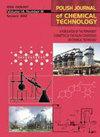Fenton法及混凝法处理肉骨粉生产废水
IF 1
4区 工程技术
Q4 CHEMISTRY, APPLIED
引用次数: 0
摘要
摘要肉骨粉生产废水中有机物和悬浮物含量高,是其处理过程中的一个重要问题。在这项工作中,我们研究了使用过氧化氢混凝和芬顿工艺处理该废水的方法。处理方案包括使用1:5–1:30的可变Fe2+/H2O2比例、3–18.0 g/L H2O2的可变剂量和5–10 mL/L的混凝剂PIX 113。计算出的还原度表明,无论使用何种处理方案,浊度(100%)、磷(99%)的还原度最大,其次是颜色(97%)、化学需氧量(70%)和凯氏氮(48%)。所提出的处理方案可作为处理肉骨粉生产废水的初步阶段。本文章由计算机程序翻译,如有差异,请以英文原文为准。
Treatment of wastewater from the production of meat and bone meal by the Fenton process and coagulation
Abstract Wastewater from the production of meat and bone meal, due to the high load of organic matter and suspended solids, is a significant problem in the process of its treatment. In this work, we examined the method of treating this wastewater using coagulation with hydrogen peroxide and the Fenton process. Treatment variants included the use of variable Fe2+/H2O2 ratios of 1:5–1:30, variable doses of 3–18.0 g/L H2O2, and 5–10 mL/L of coagulant PIX 113. The calculated reduction degrees showed that, regardless of the treatment variant used, the greatest reduction was obtained for turbidity (100%), phosphorus (99%), followed by color (97%), chemical oxygen demand (70%), and Kjeldahl nitrogen (48%). The proposed treatment options can be used as a preliminary stage in treating wastewater from the production of meat and bone meal.
求助全文
通过发布文献求助,成功后即可免费获取论文全文。
去求助
来源期刊

Polish Journal of Chemical Technology
CHEMISTRY, APPLIED-ENGINEERING, CHEMICAL
CiteScore
1.70
自引率
10.00%
发文量
22
审稿时长
4.5 months
期刊介绍:
Polish Journal of Chemical Technology is a peer-reviewed, international journal devoted to fundamental and applied chemistry, as well as chemical engineering and biotechnology research. It has a very broad scope but favors interdisciplinary research that bring chemical technology together with other disciplines. All authors receive very fast and comprehensive peer-review. Additionally, every published article is promoted to researchers working in the same field.
 求助内容:
求助内容: 应助结果提醒方式:
应助结果提醒方式:


